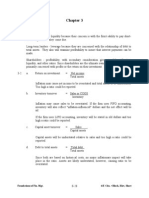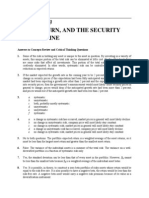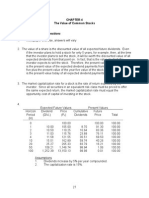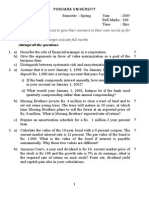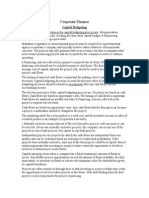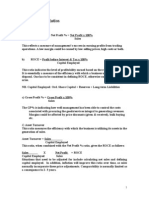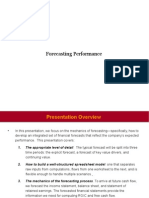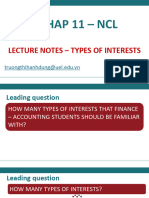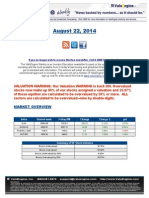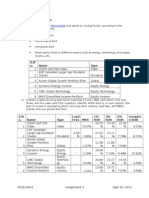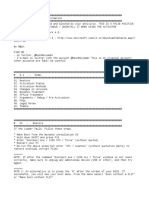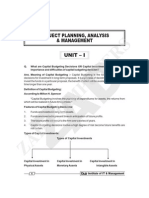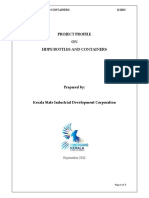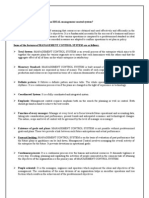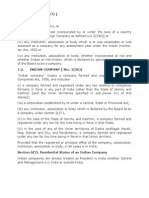Alm Asset Liability MG
Alm Asset Liability MG
Uploaded by
Aamirx64Copyright:
Available Formats
Alm Asset Liability MG
Alm Asset Liability MG
Uploaded by
Aamirx64Original Title
Copyright
Available Formats
Share this document
Did you find this document useful?
Is this content inappropriate?
Copyright:
Available Formats
Alm Asset Liability MG
Alm Asset Liability MG
Uploaded by
Aamirx64Copyright:
Available Formats
1
P
h
i
l
i
p
S
y
m
e
s
,
2
0
0
6
ASSET LIABILITY MANAGEMENT
Significance and Basic Methods
Dr Philip Symes
2
P
h
i
l
i
p
S
y
m
e
s
,
2
0
0
6
Introduction
Asset liability management (ALM) is the management of financial assets by
a company to make returns.
ALM is necessary to maximise return on capital and deal with competition
and risks
A bankers job is to strike the right balance of risk and returns
Need to watch out for regulatory constraints
Liuidity
!afety
"rofitability
#ompetiti$eness
3
P
h
i
l
i
p
S
y
m
e
s
,
2
0
0
6
Contents
%he role of banks
&isk management for ALM
'nterest rate methods
"rice sensiti$ities
(ap management
)se of swaps* caps and floors in ALM
4
P
h
i
l
i
p
S
y
m
e
s
,
2
0
0
6
Role of Banks
+ank,s own capital pro$ides the liuidity cushion between deposits and
loans
-isintermediation. withdrawal of funds from banks to in$est directly
Funds
saved by
those
who have
a surplus
Funds
borrowed
by those
who have
a deficit
Banks
A L
E
Direct
P
h
i
l
i
p
S
y
m
e
s
,
2
0
0
6
Return on Equit E!a"#le
%his example shows how banks generate a return on an
euity
'nterest rates
(ross margin
/ lending rate
/ borrowing rate
0perating cost
Net margin
net income1re$enue
Asset utilisation
re$enue1assets
&eturn on assets
net income1assets
2inancial Le$erage
assets1euity
Return on equit
net income1euity
!
P
h
i
l
i
p
S
y
m
e
s
,
2
0
0
6
Return on Equit E!a"#le
!imple example.
#urrent L'+0& 3 456
%7 cost 3 45.896
+ank borrows at 47.9 bps abo$e
L'+0&
+ank lends at 44.:56
(eneral expenses 3 95bps
"1 # $%
"2 # %
L # &&%
A
&e$enue and expenses.
Assets 3 455;
%ime period 3 4 yr.
&e$enue 3 income from
lending
3 455 < (44.:56)
3 44.:5
=xpenses 3 cost of %7 > cost
of borrowing
3 9 < (45.96) > ?? <
(456
>5.4796)
3 5.979 > ?.@4
3 @.:A9
(ross profit 3 44.:5 / .:A9
3 $%&'(
$
P
h
i
l
i
p
S
y
m
e
s
,
2
0
0
6
Return on Equit E!a"#le
Net profit 3
(ross profit / general
expenses
3 4.@B9 / 5.9
3 4.:B9
Net margin 3
Net profit 1 &e$enue
3 4.:B9 1 44.:
3 5.47?9
Asset utilisation 3
re$enue 1 assets
3 44 1 455
3 5.44
&eturn on assets 3
Net margin < Asset utilisation
3 5.47?9 < 5.44
3 5.54:4:
Le$erage 3
Assets 1 %4 capital
3 455 1 8
3 4:.7?B
&eturn on euity 3
&eturn on assets < Le$erage
3 5.54:4: < 4:.7?B
3 5.754@9
3 )*%) +
&
P
h
i
l
i
p
S
y
m
e
s
,
2
0
0
6
Risk Manage"ent
More details on risk types can be found in the
Introduction to Risk presentation
%he diagram shows the different types of risk in ALM
&isk management
Liuidity
2unding1
Le$erage
'nterest rate
sensiti$ity
#ommercial
strategy
#ompetition
&egulatory
reuirements
'
P
h
i
l
i
p
S
y
m
e
s
,
2
0
0
6
Risk Manage"ent
An effecti$e organisational structure is essential for risk
management
%reasury C #apital market
(roup %reasury
%reasury Markets
%erm
2unding
Liuidity !hort1
Medium
%erm
'nterest
&ate &isk
Long
%erm
'nterest
&ate &isk
(roup
!er$ices1
'n$estor
&elations
#orporate
Marketing
#apital
markets1
-eri$ati$es
Money
Markets
&isk
&eporting
&isk
Allocation
1(
P
h
i
l
i
p
S
y
m
e
s
,
2
0
0
6
Interest Rates
%here are different ways of calculating interest.
!imple interest
#ompound interest
-aycount con$entions (A#%* etc.) can also be confusing
!pot rates (Dero coupon rates)
)sed to calculate the time $alue of money
Eields
)sed for expressing the internal rate of return for fixed
interest coupon bonds or loans
)sed to produce yield cur$es
2orward rates
Market,s expectation of loan rates in the future
11
P
h
i
l
i
p
S
y
m
e
s
,
2
0
0
6
Interest Rates
&elationship between the different rates is shown.
+ootstrapping is used to determine spot rates from
yields.
&ate
2orward
!pot
Eield
2orward !pot Eield
2orward
!pot
Eield
Maturity
12
P
h
i
l
i
p
S
y
m
e
s
,
2
0
0
6
Interest Rates
%he process of bootstrapping is explained in the Eield
#ur$es presentation.
A simple recipe for performing bootstrapping in a
spreadsheet is.
4) #alculate the one year spot rate;
7) #alculate the one year discount factor;
A) #alculate the running sum of discount factors*
starting with year 4;
:) Multiply the running sum of discount factors by the
yield of year 7;
9) %wo year !pot rate is eual to (4 > two year yield)
di$ided by the product of step (:);
B) &epeat steps (A/9) for each successi$e year.
13
P
h
i
l
i
p
S
y
m
e
s
,
2
0
0
6
Interest Rates
=ui$alence principle is used to deri$e forward rates
from spot rates.
%his principal states that a fixed rate loan made from
today for a period of x years must earn the same
interest as a loan made for y years (where y F x) and
rolled o$er for the remaining x / y years
%his method can be simplified using discount factors
(4 > !
7
)
7
(4 > !
4
) (4 >
4
2
4
)
&oute A
&oute +
According to =ui$alence.
2uture $alue $ia route A 3 2uture
$alue $ia route +
or
(4 > !7)7 3 (4 > !4) < (4 > 424)
or 424 3 -24 1 -27 / 4
3 4.5B5A / 4
3 B.5A6
14
P
h
i
l
i
p
S
y
m
e
s
,
2
0
0
6
,rice Sensiti-ities
%he price of fixed income securities is sensiti$e to its
yield (i.e. interest rates)
%he price/yield cur$e of most securities is con$ex.
"rice
Eield #oupon rate
"ar $alue
Ghen Eield 3 #oupon rate
"rice 3 "ar $alue
Ghen Eield F #oupon rate
"rice H "ar $alue
Ghen Eield H #oupon rate
"rice F "ar $alue
1
P
h
i
l
i
p
S
y
m
e
s
,
2
0
0
6
,rice Sensiti-ities
2inancial professionals need a uick measure for price
sensiti$ity rather than using the price euation
Price Value of a Basis Point is the simplest measure of
sensiti$ity and the most widely used
"rice
Eield y
)"
y>4bp
"I+" is the change in price for 4 bp rise in yield
"I+" 3 "rice at 4bp higher yield / "rice at current yield
Ghen Eield 3 8.556 "rice 3 J455
Ghen Eield 3 8.546 "rice 3 J@@.@9@
%herefore "I+" 3 @@.@9@ / 455
3 J/5.5:4
1!
P
h
i
l
i
p
S
y
m
e
s
,
2
0
0
6
,rice Sensiti-ities
Modified Duration is another measure of sensiti$ity
't is better for securities whose price is not eual to par
Modified duration is ratio of the relati$e change in price
to the change in yield for a small yield change (i.e. 4bp)
"rice
Eield y
K"
y>4bp
Ghen Eield 3 8.556 "rice 3 ?8.B@@
Ghen Eield 3 8.546 "rice 3 ?8.BB7
K" 3 (?8.BB7 / ?8.B@@) 3 5.5A?
Ky 3 4bp 3 5.5554
%herefore MD 3 (K" 1 ") 1 Ky
3 (5.5A?1?8.B@@) 1 5.5554
3 :.A
1$
P
h
i
l
i
p
S
y
m
e
s
,
2
0
0
6
,rice Sensiti-ities
Macaulay Duration is widely used in ALM to balance the
a$erage li$es
'.e. the asset and liability sides of the balance sheet
Macaulay duration is the weighted a$erage time to
maturity of the cash flows of security; where the weights
are eual to the present $alues of the cash flows
#lear bar shows the cash flow and the shaded area is its "I
Macaulay duration can be seen graphically as the point in the
life of the security about which the $alue of the present $alues
of the cash flows are perfectly balanced
1&
P
h
i
l
i
p
S
y
m
e
s
,
2
0
0
6
,rice Sensiti-ities
As an example* consider the Macaulay duration of a
?6 fixed rate bond* 9yr duration* yielding 456.
%his can be calculated in a spreadsheet as shown.
+asis. par $alue 3 455 yield 3 456
%ime (yrs) #ash flow "I of cash flow %ime < "I
4 ?.55 8.78 8.78
7 ?.55 B.B4 4A.77
A ?.55 B.54 4?.5A
: ?.55 9.:B 74.?B
9 45?.55 B8.5B AA9.A5
%otal @7.:7 A@9.B?
Macaulay duration :.7?
1'
P
h
i
l
i
p
S
y
m
e
s
,
2
0
0
6
,rice Sensiti-ities
-uration pro$ides a linear estimation of the price
change for a small change in yield
2or large changes in yield it may be necessary to use
con$exity to find the change in price
"rice
Eield
Actual cur$e. K" 3 f (K r)
K " 3 duration < " < K r
K " 3 duration < " < K r > #on$exity < " < K r
7
1 7
2(
P
h
i
l
i
p
S
y
m
e
s
,
2
0
0
6
,rice Sensiti-ities
As an example of con$exity* consider a 9/year* fixed/
coupon :6 bond* yielding 86.
#on$exity is the ratio of the change in duration of the to
the change in yield for a small change in yield (4bp)* so.
Ghen yield 3 8.556 "rice 3 ?8.B@@
Ghen yield 3 8.546 "rice 3 ?8.BB7
Ghen yield 3 B.@@6 "rice 3 ?8.8A8
%hus when yield 3 B.@@ 6* -uration 3 :.7@?B
And when yield 3 8.556* -uration 3 :.A55@
%herefore #on$exity 3 (:.A55@ / :.7@?B) 1 5.5554
3 ).%//
21
P
h
i
l
i
p
S
y
m
e
s
,
2
0
0
6
,rice Sensiti-ities
2ixed rate loans are like bonds and aren,t con$ex.
Loan sensiti$ities can be described by duration.
directly on maturity (duration can,t exceed maturity);
directly on coupon rate;
in$ersely on yield.
-uration
Maturity
-uration of par loans
-uration of Dero coupon loans
22
P
h
i
l
i
p
S
y
m
e
s
,
2
0
0
6
,rice Sensiti-ities
2loating rate loans are effecti$ely fixed rate loans for the
current interest calculation period.
0n the next payment date the $alue of a floating rate loan is
eual to the principal $alue.
-uration is an adeuate measure of the sensiti$ity of a
floating rate note;
-uration of a floating rate note is close to maturity.
2or example* mortgages and consumer loans can ha$e
embedded optionality.
"rice sensiti$ity is based on duration and con$exity;
"repayment risk must be modelled and obser$ed.
23
P
h
i
l
i
p
S
y
m
e
s
,
2
0
0
6
,rice Sensiti-ities
-ifferent yield sensiti$e securities make up a portfolio.
%he change in price of each security for one basis point
mo$e in yields will be depend on its duration;
!o a change in the yield cur$e will securities differently.
Eield cur$es mo$e in the following ways.
856 of the mo$ement in yields can be explained by
parallel mo$es alone;
Another 75/796 can be explained by including
steepening mo$es;
96 is accounted for by cur$ature shifts.
!ee the Yield Curves presentation for more details.
24
P
h
i
l
i
p
S
y
m
e
s
,
2
0
0
6
Ga# Manage"ent
(ap management is the oldest and the most basic
method of managing the balance sheet.
%he (ap is difference between the amount of assets
and liabilities with interest rate sensiti$e cash/flows.
A positi$e (ap exists when the assets exceed liabilities.
+anks want to keep a positi$e (ap when interest rates
are rising* and a negati$e (ap when they are falling.
4755
@55
4795
855
495
'nterest
sensiti$e
assets
'nterest
sensiti$e
liabilities
(ap 3 / 95
=xample.
2
P
h
i
l
i
p
S
y
m
e
s
,
2
0
0
6
Ga# Manage"ent
%he (ap method can be refined using maturity buckets.
Bucket Gap Management.
Maturity buckets are well defined time periods that a
bank monitors on a regular basis.
%he assets and liabilities are separately clumped into
these buckets (these can be fine tuned later).
%he (ap management techniues are then applied.
:55
@55
B55
855
495
'nterest
sensiti$e
assets
'nterest
sensiti$e
liabilities
955
A55
955
495
Negati$e (ap of 755
in 5 / A months
Lero (ap in
A / B months
"ositi$e (ap of 495
in B / 47 months
2!
P
h
i
l
i
p
S
y
m
e
s
,
2
0
0
6
Ga# Manage"ent
%raditional (ap method focuses on the effect of
changes in yield on the income margin.
Duration Gap Management emphasises the effect of
yield changes on the MtM $alue of assets and liabilities
'.e. capital gains and losses.
%he -uration (ap uses the Macaulay -urations of the
assets and liabilities.
2$
P
h
i
l
i
p
S
y
m
e
s
,
2
0
0
6
Ga# Manage"ent
%ake an example of this.
Macaulay duration of assets 3 7.?8
Macaulay duration of liabilities 3 4.89
-uration gap 3 4.47
'mplies that the bank will benefit if interest rates go down.
N+. there are wide duration gaps between asset and
liabilities in different maturity buckets.
0uration
All figures in millions Lloty and are actual market $alues
Assets Ialue -uration Lia1ilities Ialue -uration
#ash 495 5.55 -emand deposits B55 5.5?
!hort term go$ernment securities A55 5.@4 !hort term time deposits 955 5.A9
Long term go$ernment securities A55 8.74 Long term time deposits 955 7.79
Migh uality floating rate loans 955 5.:9 +onds issued 755 A.97
Medium uality floating rate loans :55 5.78 0ther borrowings 495 5.89
2ixed rate loans :55 B.?8 =uity 495 45.55
0ther assets 95 45.55
Total )$** )%23 Total lia1ilities )$** $%3(
2&
P
h
i
l
i
p
S
y
m
e
s
,
2
0
0
6
Ga# Manage"ent
avings ! "oans Crisis in )!A.
!CL offer.
deposit accounts to sa$ers;
mortgages to home buyers.
!imilar to building societies.
-uring the early and mid 4@?5s
about @55 !a$ings and Loans
went bankrupt.
%he total bill for the )!
go$ernment was o$er J955 +N
Ghat went wrongN
?5
B5
A7
?
#ash
-emand
deposits
48
A
2ixed
deposits
!ecurities
Mortgages
=uity
N+. %he assets are
mostly fixed rate with a
duration of 8.5 while a
siDeable portion of
liabilities is floating rate
gi$ing a duration of A.5
A typical !CL.
2'
P
h
i
l
i
p
S
y
m
e
s
,
2
0
0
6
Ga# Manage"ent
%he duration gap became disastrous when interest
rates increased.
-uring late 4@85s and early 4@?5s interest rates were
$olatile and rose by about A6.
%hus the $alue of !CL assets declined by about 756.
K"(assets) 3 - < K y > 417 < #on$ < K y
7
3 /8 < 5.5A > 5.9 < 77 <5.555@ 3 5.75 3 756
+ut the $alue of the liabilities only went up by about ?6
K "(liabilities) 3 - < K y > 417 < #on$ < K y
7
3 /A < 5.5A > 5.9 < 75 <5.555@ 3 5.5? 3 ?6
%hus our !CL suffered a capital loss of 476 which was
more than its euity of ?6 / and went bankrupt.
3(
P
h
i
l
i
p
S
y
m
e
s
,
2
0
0
6
4se of S5a#s6 Ca#s 7 8loors in ALM
A !wap is a contract between two counterparties to
exchange specified streams of cash flows o$er a gi$en
period
=ach exchange of cash flows in the swap can be seen
as a forward contract
A plain $anilla swap is an exchange of a fixed interest
stream for a floating interest stream (e.g. L'+0&)
$%
*
*
*
*
$% $%
$%
!+th L
$%
!+th L !+th L !+th L !+th L
%ime(yr) 2ixed 2loating
5.5 5 5
5.9 "<5.58<Kt /"<Bm L<)t
4.5 "<5.58<)t /"<Bm L<)t
4.9 "<5.58<)t /"<Bm L<)t
7.5 "<5.58<)t /"<Bm L<)t
7.9 "<5.58<)t /"<Bm L<)t
=.g.. 7.9 yr swap where we recei$e 86 and pay Bmth L'+0&.
31
P
h
i
l
i
p
S
y
m
e
s
,
2
0
0
6
4se of S5a#s6 Ca#s 7 8loors in ALM
A bank can use a swap to change the duration of its
assets or liabilities* e.g..
+ank A
:yr +ond
yielding ?6
2ixed
+ank A is long a fixed rate asset with a duration of A.9
+ank A
2ixed
2loating
+ank A goes short a swap with a duration of A.9
+ank A
2loating
As a result* +ank A reduces the duration of its asset to 5.:
32
P
h
i
l
i
p
S
y
m
e
s
,
2
0
0
6
4se of S5a#s6 Ca#s 7 8loors in ALM
A swap can be $alued as a
series of cash flows
%he MtM $alue the sum of the
N"I of all cash flows*
discounted at the swap rate
%he $alue of a swap is the N"I
of the fixed side cash flows*
discounted at the swap rate
'f the MtM $alue is non/Dero*
one of the counterparty is losing
money
=xample.
8 yr swap of notional amount of
455* where we recei$e 45.96
semi/annually and pay Bmth
L'+0& / 95 bps
#urrent 8 year swap rate is @6
"I of floating side 3
/455 > "I of 95 bps o$er 8 yrs
3 /455 > 7.99 3 @8.:9
#oupon of fixed side 3 45.96
Eield of fixed side 3 @6
Maturity 3 8 yrs
"I of fixed side 3 458.B8
N"I of swap 3
/@8.:9 > 458.B8 3 $*%))
33
P
h
i
l
i
p
S
y
m
e
s
,
2
0
0
6
4se of S5a#s6 Ca#s 7 8loors in ALM
#aps and floors are deri$ati$e contracts where the
owner can recei$e the difference between a strike
interest rate and the le$el of an index* e.g. L'+0&
A cap is like a series of options where the owner has a
right to exchange fixed for floating interest payments
A floor is like a series of options where the owner has a
right to exchange floating for fixed interest payments
#ash flow
L'+0&
#ap
L'+0&
2loor
#ash flow
N+. #ap and floor are show from the owner,s perspecti$e
!trike !trike
34
P
h
i
l
i
p
S
y
m
e
s
,
2
0
0
6
4se of S5a#s6 Ca#s 7 8loors in ALM
A bank can limit the interest expense of a floating rate
liability by buying a cap
%he expense of capping a floating rate liability can be
reduced by selling a floor
#ash inflow
L'+0&
#ap
=xpense
L'+0&
2loating &ate Liability
=xpense
L'+0&
O#ollaredP 2loating &ate Liability
!c
!c
#ash outflow
L'+0&
2loor
!f
!f
3
P
h
i
l
i
p
S
y
m
e
s
,
2
0
0
6
4se of S5a#s6 Ca#s 7 8loors in ALM
A long cap and a short floor can make a costless collar.
A swap is a kind of costless collar.
#aps and floors are series of distinct interest rate options.
Ialue of an interest rate option is composed of two parts.
'ntrinsic $alue. the gain from exercising the options
today (depends only on current le$el of interest rates);
%ime $alue. the potential gain due to future
mo$ements in interest rates up to option expiry
depends on $olatility of rates.
Iarious models are a$ailable for modelling interest rate
options.
Analytical models such as +lack/!choles;
Numerical methods. binomial* trinomial*Q
3!
P
h
i
l
i
p
S
y
m
e
s
,
2
0
0
6
4se of S5a#s6 Ca#s 7 8loors in ALM
%here are se$eral reasons for using deri$ati$es in ALM.
Medge. reduction of a part or all of a bank,s exposure;
Arbitrage. exploitation of arbitrage opportunities;
!peculate. creation of new exposures for market
oriented hedging;
"ortfolio management. de/linking maturity and
duration.
'f you belie$e rates will rise (abo$e market expectation) or
that the yield cur$e will steepen* go short on swaps
Iice/$ersa / increase the duration of assets and decrease
duration of liabilities* i.e. go long on swaps
3$
P
h
i
l
i
p
S
y
m
e
s
,
2
0
0
6
4se of S5a#s6 Ca#s 7 8loors in ALM
+ut* if you,re not sure about the rates but want to hedge*
buy an option to switch* e.g..
=
x
p
e
n
s
e
'nterest rate
2loating rate debt
=
x
p
e
n
s
e
'nterest rate
!elling a cap to subsidise the first one
=
x
p
e
n
s
e
'nterest rate
+uying a cap for protection
=
x
p
e
n
s
e
'nterest rate
!elling a floor to subsidise the cap. collar
3&
P
h
i
l
i
p
S
y
m
e
s
,
2
0
0
6
4se of S5a#s6 Ca#s 7 8loors in ALM
Application of a non/generic swap.
A diff swap is a contract to exchange two stream which
are based on indices in two different currencies.
=.g. (+" L'+0& and )!- L'+0&;
N+. %he payments are in the same currency.
%his swap is used to bet on the relati$e steepness of
swap cur$es in the two currencies.
+ank A +ank +
)!- L'+0& >A79bps
(+" L'+0&
3'
P
h
i
l
i
p
S
y
m
e
s
,
2
0
0
6
4se of S5a#s6 Ca#s 7 8loors in ALM
-eri$ati$es can be used to add $alue in se$eral ways.
-eri$ati$es are cheaper than physical transactions.
-eri$ati$es are off balance sheet.
-eri$ati$es can reduce taxes and hence add $alue for
shareholders
hedging debt reduces risk;
the cost of hedging is usually tax deductible;
lower interest rate risk means that the firm can
increase other types of risk.
R
Le$eraged to enhance returns for shareholders.
4(
P
h
i
l
i
p
S
y
m
e
s
,
2
0
0
6
Su""ar
ALM is the management of assets and liabilities in banks
to add $alue to portfolios.
'nterest rates are a major factor in the $alue of many
financial instruments.
"rice sensiti$ity is how much a change in yield changes
the price* and this depends on duration.
(ap analysis is the management of the balance sheet to
simply protect portfolios.
-eri$ati$es can be used to le$erage positions* hedge
risk and add $alue to portfolios.
You might also like
- Harris Seafoods Case StudyDocument7 pagesHarris Seafoods Case StudyAmazon Will83% (6)
- Creating Shareholder Value: A Guide For Managers And InvestorsFrom EverandCreating Shareholder Value: A Guide For Managers And InvestorsRating: 4.5 out of 5 stars4.5/5 (9)
- Shapiro CHAPTER 5 SolutionsDocument11 pagesShapiro CHAPTER 5 Solutionsjimmy_chou13140% (1)
- Reconsider the Welte Mutual Funds problem from Section 9.2. Define your decision variables as the fraction of funds invested in each security. Also, modify the constraints limiting investments in the oil and steel industries as follows: No more than 50% of the total funds invested in stock (oil and steel) may be invested in the oil industry, and no more than 50% of the funds invested in stock (oil and steel) may be invested in the steel industry.Document2 pagesReconsider the Welte Mutual Funds problem from Section 9.2. Define your decision variables as the fraction of funds invested in each security. Also, modify the constraints limiting investments in the oil and steel industries as follows: No more than 50% of the total funds invested in stock (oil and steel) may be invested in the oil industry, and no more than 50% of the funds invested in stock (oil and steel) may be invested in the steel industry.Waqas Ahmed100% (1)
- Case 01a Growing Pains SolutionDocument7 pagesCase 01a Growing Pains Solution01dynamic33% (3)
- Performance Evaluation of Mutual Funds in IndiaDocument40 pagesPerformance Evaluation of Mutual Funds in IndiafathimathabasumNo ratings yet
- Shapiro CHAPTER 2 SolutionsDocument14 pagesShapiro CHAPTER 2 Solutionsjimmy_chou1314100% (1)
- SM Chapter 06Document42 pagesSM Chapter 06mfawzi010No ratings yet
- Balance Sheet StatementDocument8 pagesBalance Sheet StatementsantasantitaNo ratings yet
- Chapter 08Document18 pagesChapter 08Tam NguyenNo ratings yet
- Discussion Questions: Foundations of Fin. Mgt. 6/E Cdn. - Block, Hirt, ShortDocument32 pagesDiscussion Questions: Foundations of Fin. Mgt. 6/E Cdn. - Block, Hirt, ShortElvis169No ratings yet
- Chapter 13Document15 pagesChapter 13runner4peaceNo ratings yet
- Answers To Practice Questions: The Value of Common StocksDocument11 pagesAnswers To Practice Questions: The Value of Common StocksAndrea RobinsonNo ratings yet
- Course 3: Capital Budgeting AnalysisDocument20 pagesCourse 3: Capital Budgeting Analysisjimmy_chou1314No ratings yet
- CH 10Document23 pagesCH 10Junaid JamshaidNo ratings yet
- Capital BudgetingDocument48 pagesCapital Budgetingkingword84% (19)
- Chapter 14 Capital Structure and Financial Ratios: 1. ObjectivesDocument17 pagesChapter 14 Capital Structure and Financial Ratios: 1. Objectivessamuel_dwumfourNo ratings yet
- Mg2451 Engineering Economics and Cost Analysis Questions and AnswersDocument11 pagesMg2451 Engineering Economics and Cost Analysis Questions and AnswersVijayakumarBaskarNo ratings yet
- Financial Ratios Analysis Report-SKSDocument6 pagesFinancial Ratios Analysis Report-SKSRamendra KumarNo ratings yet
- 9 Capital BudgetingDocument6 pages9 Capital BudgetingRavichandran SeenivasanNo ratings yet
- Hca14 SM Ch06Document47 pagesHca14 SM Ch06DrellyNo ratings yet
- Shapiro CHAPTER 2 SolutionsDocument14 pagesShapiro CHAPTER 2 SolutionsPradeep HemachandranNo ratings yet
- Financial Analysis 105-115Document10 pagesFinancial Analysis 105-115deshpandep33No ratings yet
- CIMA F2 Refresher - Qunber RazaDocument91 pagesCIMA F2 Refresher - Qunber RazaMr RizviNo ratings yet
- Asset Allocation (Sharpe)Document28 pagesAsset Allocation (Sharpe)mjvicunaNo ratings yet
- Credit Appraisal TechniquesDocument35 pagesCredit Appraisal TechniquesDilip RkNo ratings yet
- Time Interest Earned RatioDocument40 pagesTime Interest Earned RatioFarihaFardeenNo ratings yet
- Candidates Are Required To Give Their Answers in Their Own Words As Far As Practicable. The Figures in The Margin Indicate Full MarksDocument4 pagesCandidates Are Required To Give Their Answers in Their Own Words As Far As Practicable. The Figures in The Margin Indicate Full Marksrenutimilsena1439No ratings yet
- Corporate FinanceDocument13 pagesCorporate FinanceAditya BajoriaNo ratings yet
- Case of Cost of Capital - PrasannachandraDocument13 pagesCase of Cost of Capital - PrasannachandraJyotiGhanchiNo ratings yet
- Solution 2011Document16 pagesSolution 2011Krutika MehtaNo ratings yet
- UploadedFile 130364571293527064Document73 pagesUploadedFile 130364571293527064salujahimanshu1691No ratings yet
- Final Practice Questions and SolutionsDocument12 pagesFinal Practice Questions and Solutionsshaikhnazneen100No ratings yet
- Professional Accounting College of The Caribbean (Pacc) : Ratio Analysis / Performance AppraisalDocument4 pagesProfessional Accounting College of The Caribbean (Pacc) : Ratio Analysis / Performance AppraisalNicquainCTNo ratings yet
- Net Present Value and Other Investment Rules: Mcgraw-Hill/IrwinDocument34 pagesNet Present Value and Other Investment Rules: Mcgraw-Hill/Irwinveronica1085No ratings yet
- Categories of RatiosDocument6 pagesCategories of RatiosNicquainCTNo ratings yet
- Chapter08 KGWDocument24 pagesChapter08 KGWMir Zain Ul HassanNo ratings yet
- 02. CHAP 11 – Interests - lecture notes - studentsDocument23 pages02. CHAP 11 – Interests - lecture notes - studentsPansa HemviboonNo ratings yet
- CHAPTER 16 AnswersDocument16 pagesCHAPTER 16 AnswersNeesa V HoseinNo ratings yet
- ValuEngine Weekly Newsletter August 22, 2014Document11 pagesValuEngine Weekly Newsletter August 22, 2014ValuEngine.comNo ratings yet
- Revision 1 - Financial Management, Financial Objectives and Financial EnvironmentDocument11 pagesRevision 1 - Financial Management, Financial Objectives and Financial Environmentsamuel_dwumfourNo ratings yet
- Guía de EjerciciosDocument34 pagesGuía de EjerciciosLindsay RommyNo ratings yet
- Valuing Stocks: Third EditionDocument29 pagesValuing Stocks: Third EditionMuhammad IsmailNo ratings yet
- Master of Business Administration: Project Report Optimization of Portfolio Risk and ReturnDocument55 pagesMaster of Business Administration: Project Report Optimization of Portfolio Risk and ReturnpiusadrienNo ratings yet
- Assignment 3Document5 pagesAssignment 3aklank_218105No ratings yet
- Certificate: Mr. Neeraj Gupta "Financial Performance Analysis of NTPC"Document17 pagesCertificate: Mr. Neeraj Gupta "Financial Performance Analysis of NTPC"ajaynegi71No ratings yet
- Active Passive Debate; Market Cyclicality and Leadership VolatilityDocument14 pagesActive Passive Debate; Market Cyclicality and Leadership VolatilityTolu AkinrimisiNo ratings yet
- Asset Allocation PrinciplesDocument32 pagesAsset Allocation PrinciplesVamsi KrishnaNo ratings yet
- What Is The Difference Between Independent and Mutually Exclusive Projects?Document8 pagesWhat Is The Difference Between Independent and Mutually Exclusive Projects?9492860119No ratings yet
- Fubuki Case Assignment FINALDocument4 pagesFubuki Case Assignment FINALnowgamiNo ratings yet
- An Introduction To Risk and Return-History of Financial Market ReturnsDocument10 pagesAn Introduction To Risk and Return-History of Financial Market ReturnsanisaNo ratings yet
- Chapter 04 IM 10th EdDocument37 pagesChapter 04 IM 10th EdMary Grace de RamosNo ratings yet
- Financial Management Part 2 RN 12.3.2013 JRM Capital Budgeting Decisions C CDocument7 pagesFinancial Management Part 2 RN 12.3.2013 JRM Capital Budgeting Decisions C CQueenielyn TagraNo ratings yet
- CH 06Document21 pagesCH 06Junaid JamshaidNo ratings yet
- Multiple EABDDocument33 pagesMultiple EABDlishpa123No ratings yet
- Chap 018Document53 pagesChap 018saud1411100% (2)
- The Spreadsheet Perpetual Inventory Method: A simple and non-mathematical method to calculate stocks from flows using spreadsheetsFrom EverandThe Spreadsheet Perpetual Inventory Method: A simple and non-mathematical method to calculate stocks from flows using spreadsheetsNo ratings yet
- Monetary Policy and Macroprudential Regulation with Financial FrictionsFrom EverandMonetary Policy and Macroprudential Regulation with Financial FrictionsNo ratings yet
- Beyond Earnings: Applying the HOLT CFROI and Economic Profit FrameworkFrom EverandBeyond Earnings: Applying the HOLT CFROI and Economic Profit FrameworkNo ratings yet
- List of the Most Important Financial Ratios: Formulas and Calculation Examples Defined for Different Types of Key Financial RatiosFrom EverandList of the Most Important Financial Ratios: Formulas and Calculation Examples Defined for Different Types of Key Financial RatiosNo ratings yet
- Nerolac ListDocument6 pagesNerolac ListAamirx64No ratings yet
- ReadmeDocument10 pagesReadmeAamirx64No ratings yet
- Final Account Statements From Tally - Erp 9 - Tally Downloads - Tally AMC - Tally - NET ServicesDocument67 pagesFinal Account Statements From Tally - Erp 9 - Tally Downloads - Tally AMC - Tally - NET ServicesjohnabrahamstanNo ratings yet
- Project PlanningDocument54 pagesProject PlanningmdkaikiniNo ratings yet
- CB2 MFCDocument15 pagesCB2 MFCAamirx64No ratings yet
- Project Profile-HDPE Bottles & ContainersDocument7 pagesProject Profile-HDPE Bottles & ContainersSiddharth SinghNo ratings yet
- ASTM Laboratory Information Management Systems Rte1nzgDocument27 pagesASTM Laboratory Information Management Systems Rte1nzgAamirx64No ratings yet
- Management Control System Processes, Stages, Internal Control, Financial ControlDocument80 pagesManagement Control System Processes, Stages, Internal Control, Financial ControlAnuranjanSinha85% (13)
- Q4. What Is Strategic Business Unit? What Are Conditions Required For Creating An Sbu? How Is Performance of Sbu Measured? What Are The Advantages and Disadvantages of Creating Sbus?Document4 pagesQ4. What Is Strategic Business Unit? What Are Conditions Required For Creating An Sbu? How Is Performance of Sbu Measured? What Are The Advantages and Disadvantages of Creating Sbus?Jitendra AshaniNo ratings yet
- Syllabus For: Master of Finance & Control (MFC)Document10 pagesSyllabus For: Master of Finance & Control (MFC)Aamirx64No ratings yet
- Market Analysis: Market Analysis Is The First Step of Project Analysis. It Simply Estimates TheDocument10 pagesMarket Analysis: Market Analysis Is The First Step of Project Analysis. It Simply Estimates TheAamirx64No ratings yet
- Strategic Management: "Insights and Hard Work Deliver Results"Document30 pagesStrategic Management: "Insights and Hard Work Deliver Results"Aamirx64100% (1)
- COMPANY (Sec. 2 (17) )Document8 pagesCOMPANY (Sec. 2 (17) )Aamirx64No ratings yet
- Strategic VisionDocument8 pagesStrategic VisionAamirx64No ratings yet
- Strategic Gap AnalysisDocument9 pagesStrategic Gap AnalysisAamirx64No ratings yet
- Strategic Policies, Plans Standard Operating ProceduresDocument10 pagesStrategic Policies, Plans Standard Operating ProceduresAamirx64No ratings yet
- M1 & M2:: Strategy & Resources Firm & Environment 1Document61 pagesM1 & M2:: Strategy & Resources Firm & Environment 1Aamirx64100% (2)
- The External Environment:: Opportunities, Threats, Industry Competition, and Competitor AnalysisDocument28 pagesThe External Environment:: Opportunities, Threats, Industry Competition, and Competitor AnalysisAamirx64No ratings yet
- Business Strategic ManagementDocument38 pagesBusiness Strategic ManagementAamirx64No ratings yet










